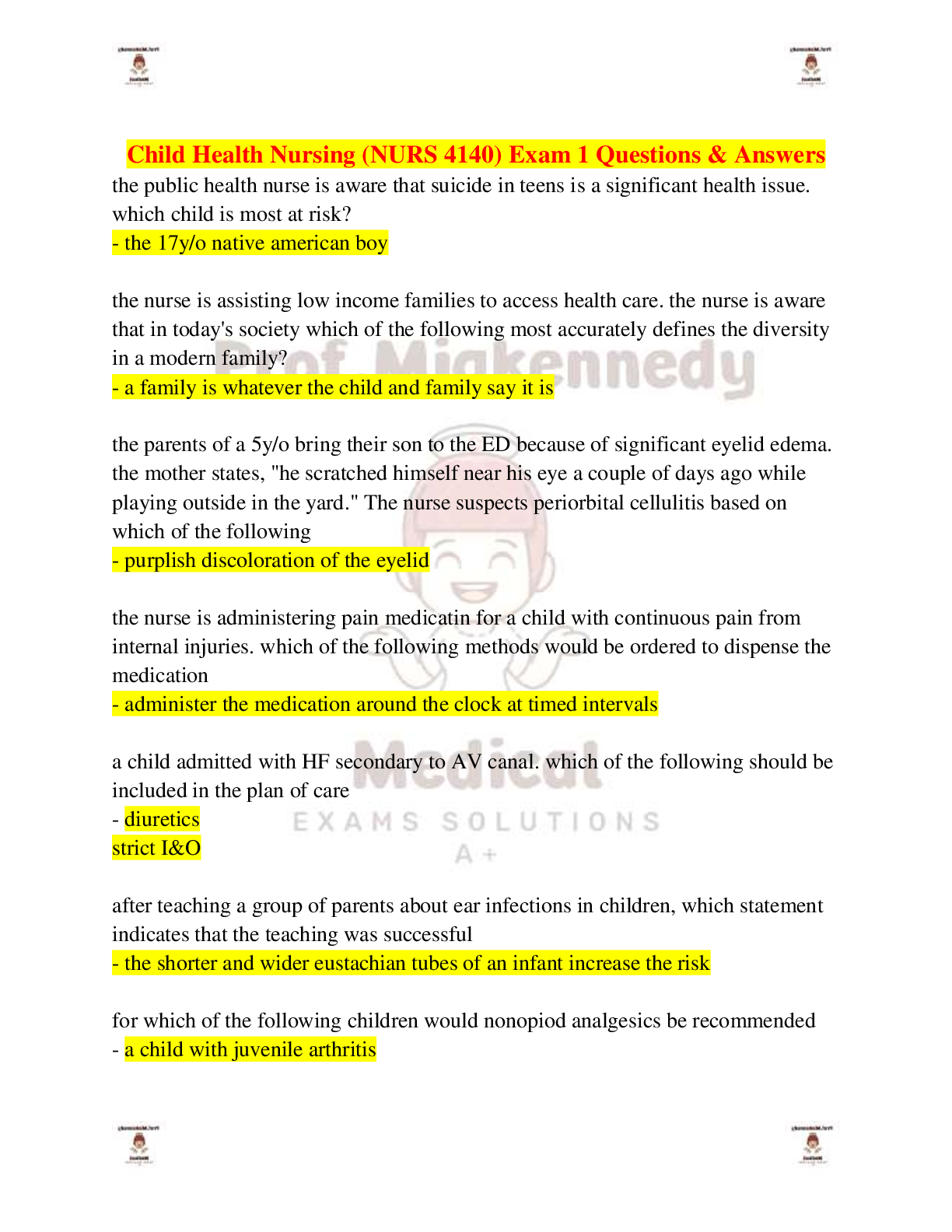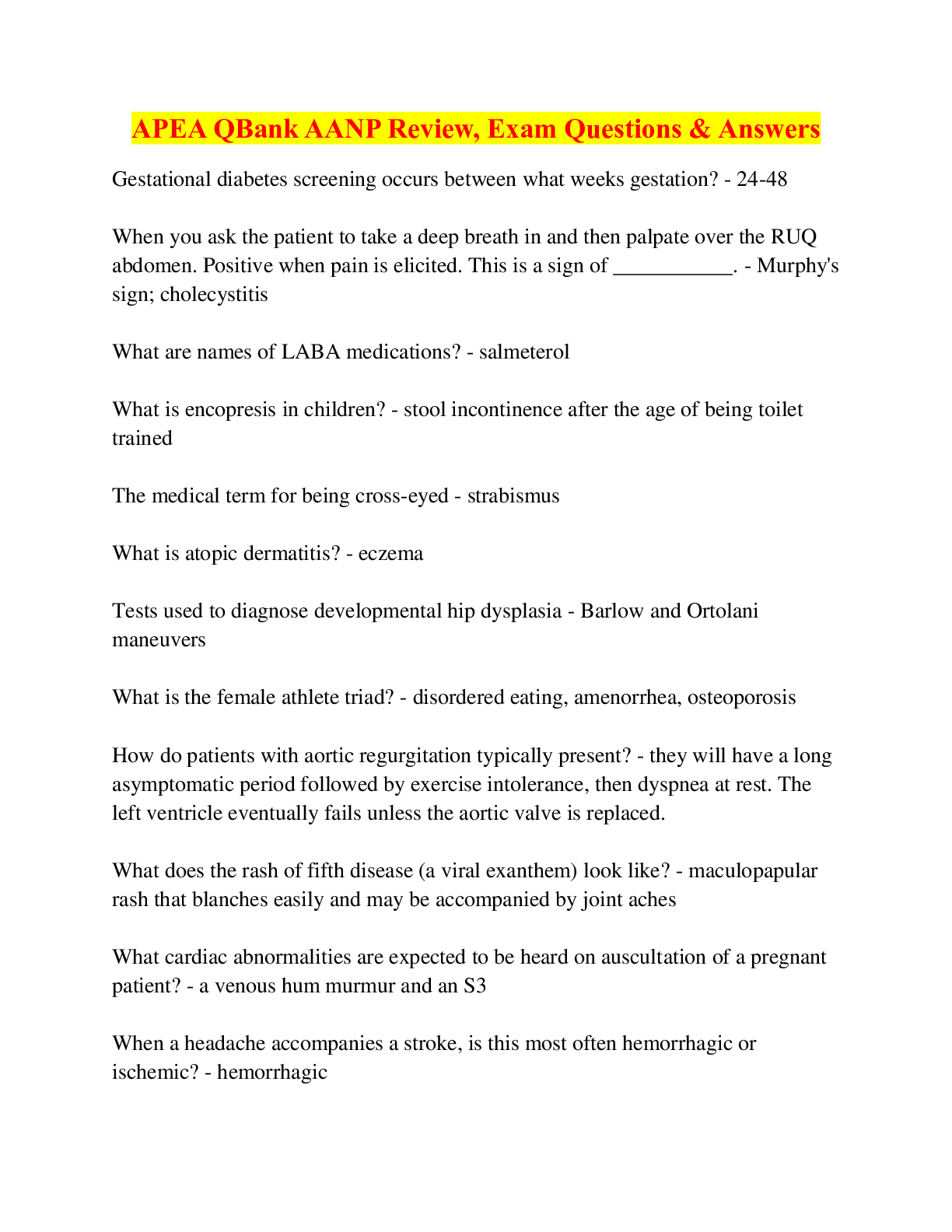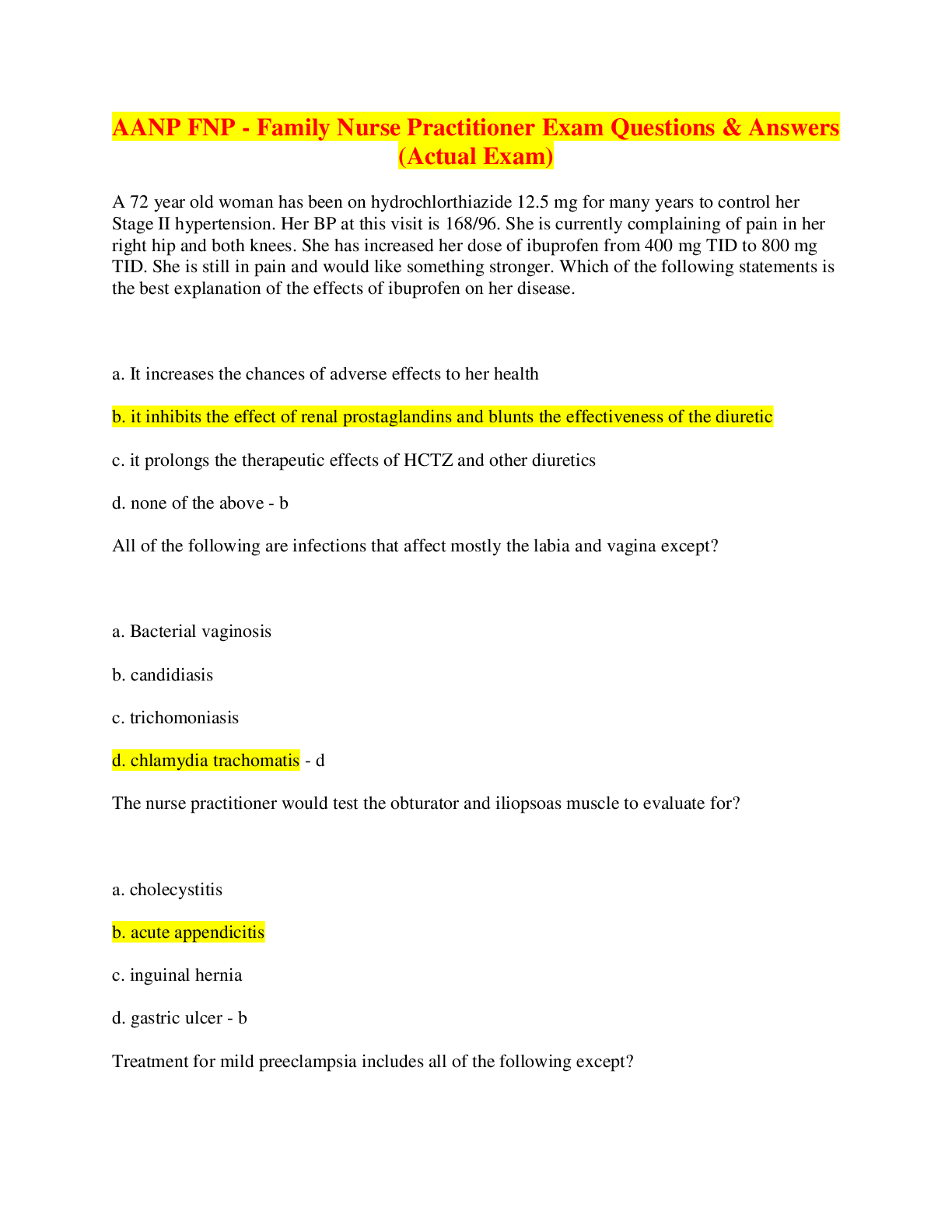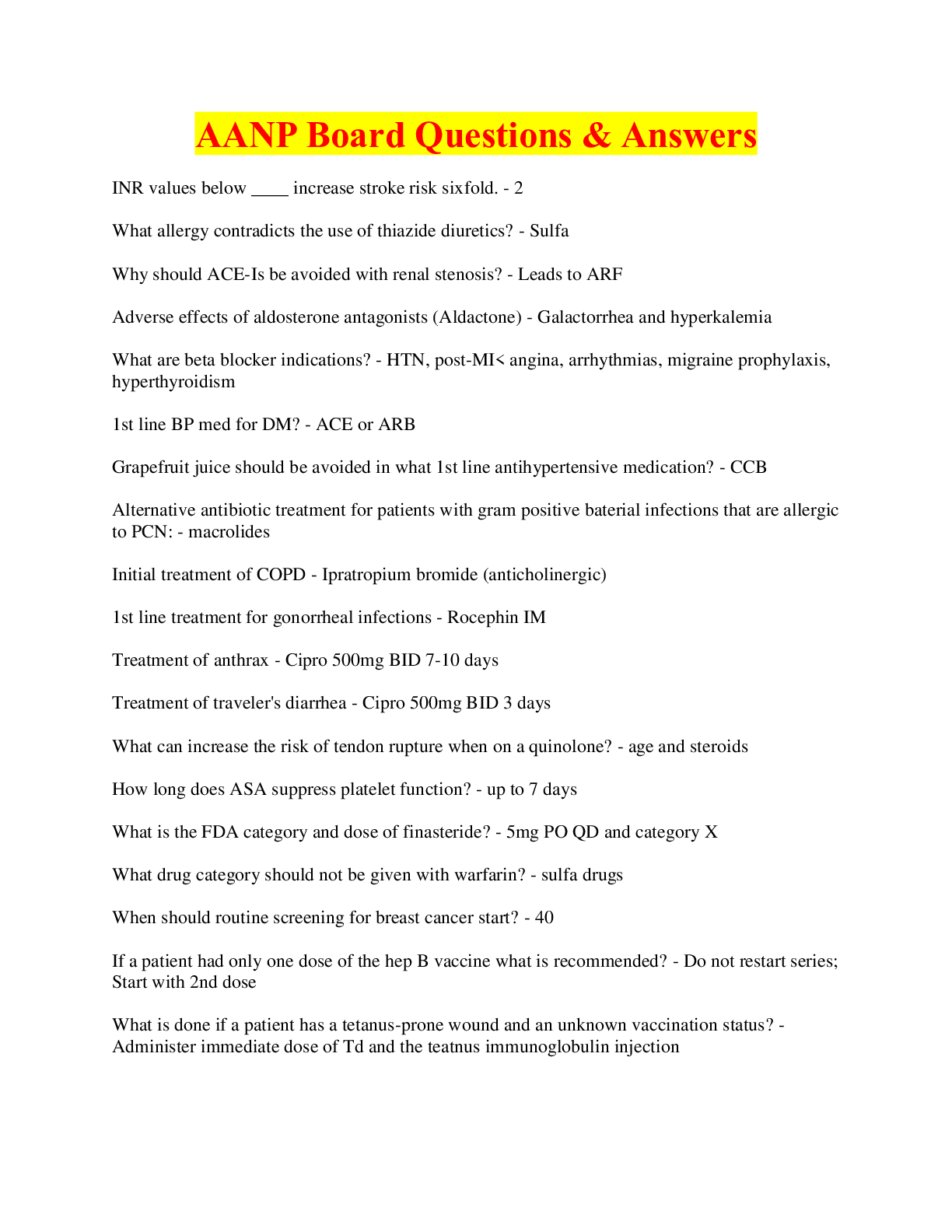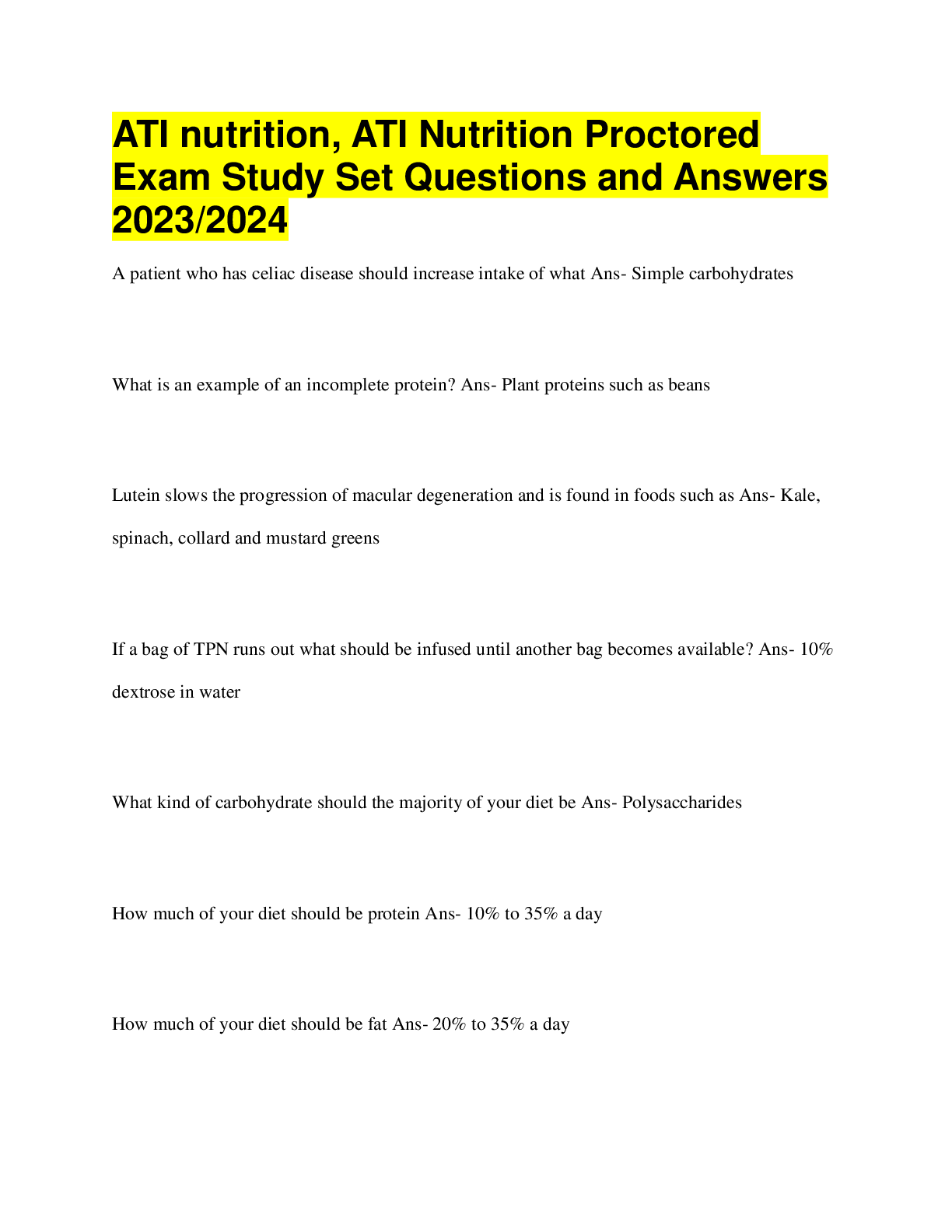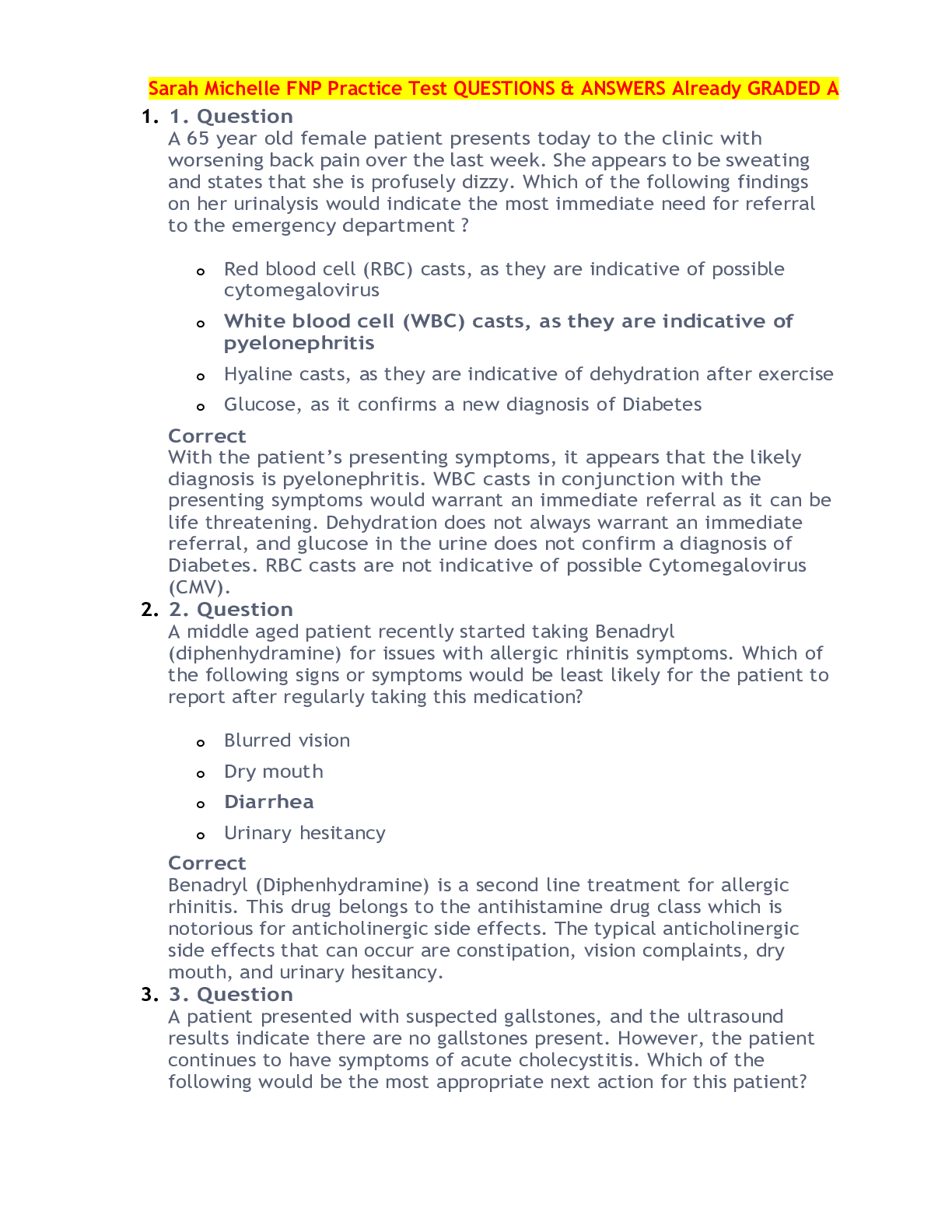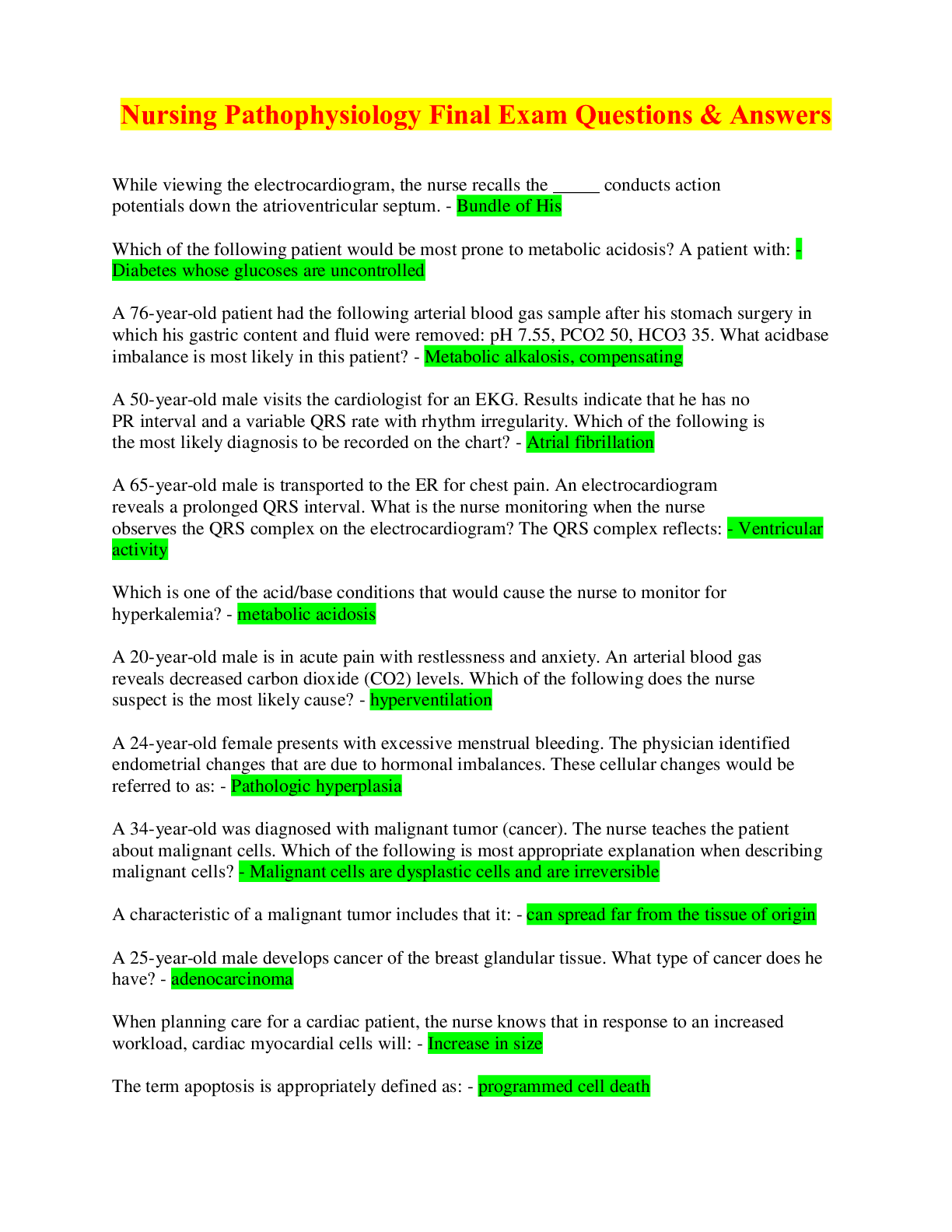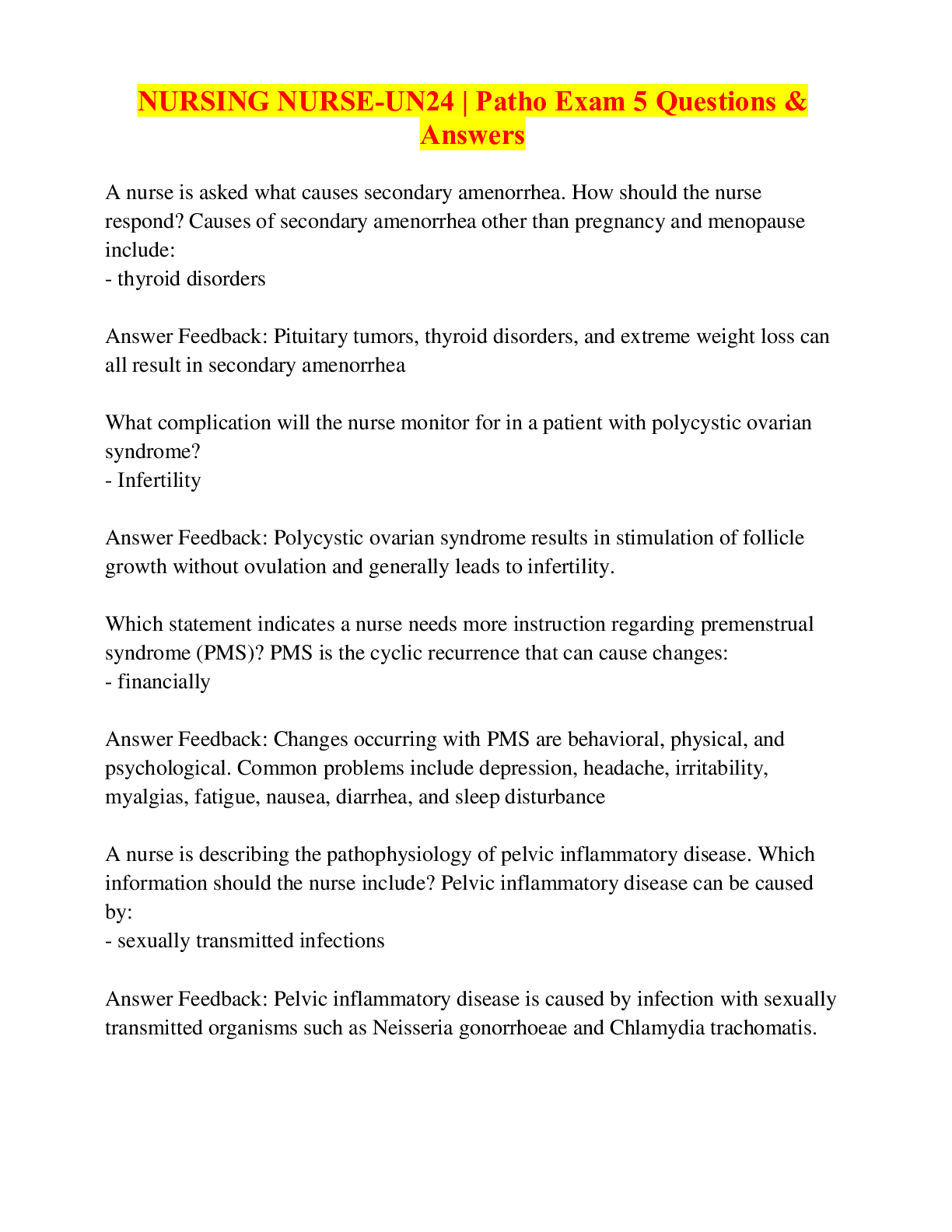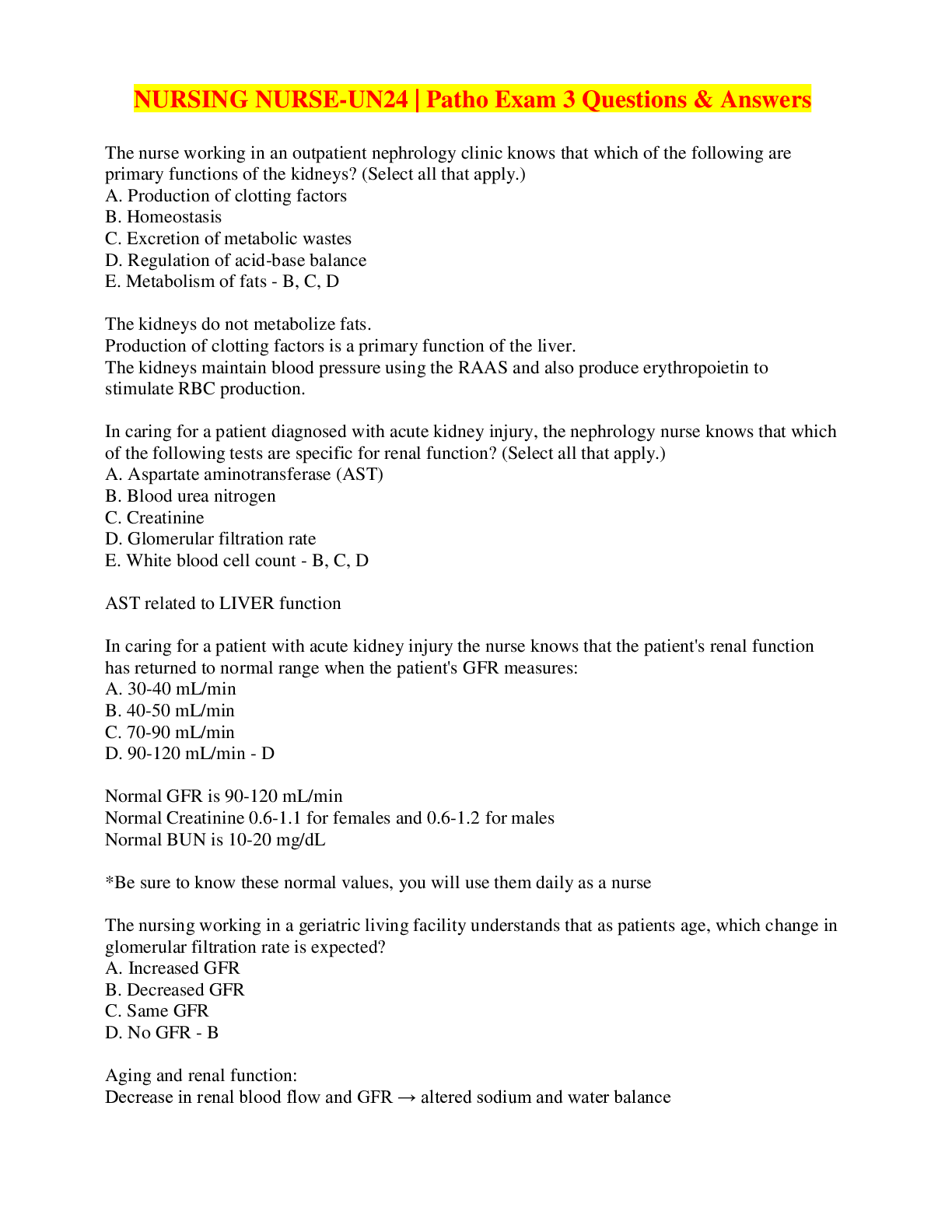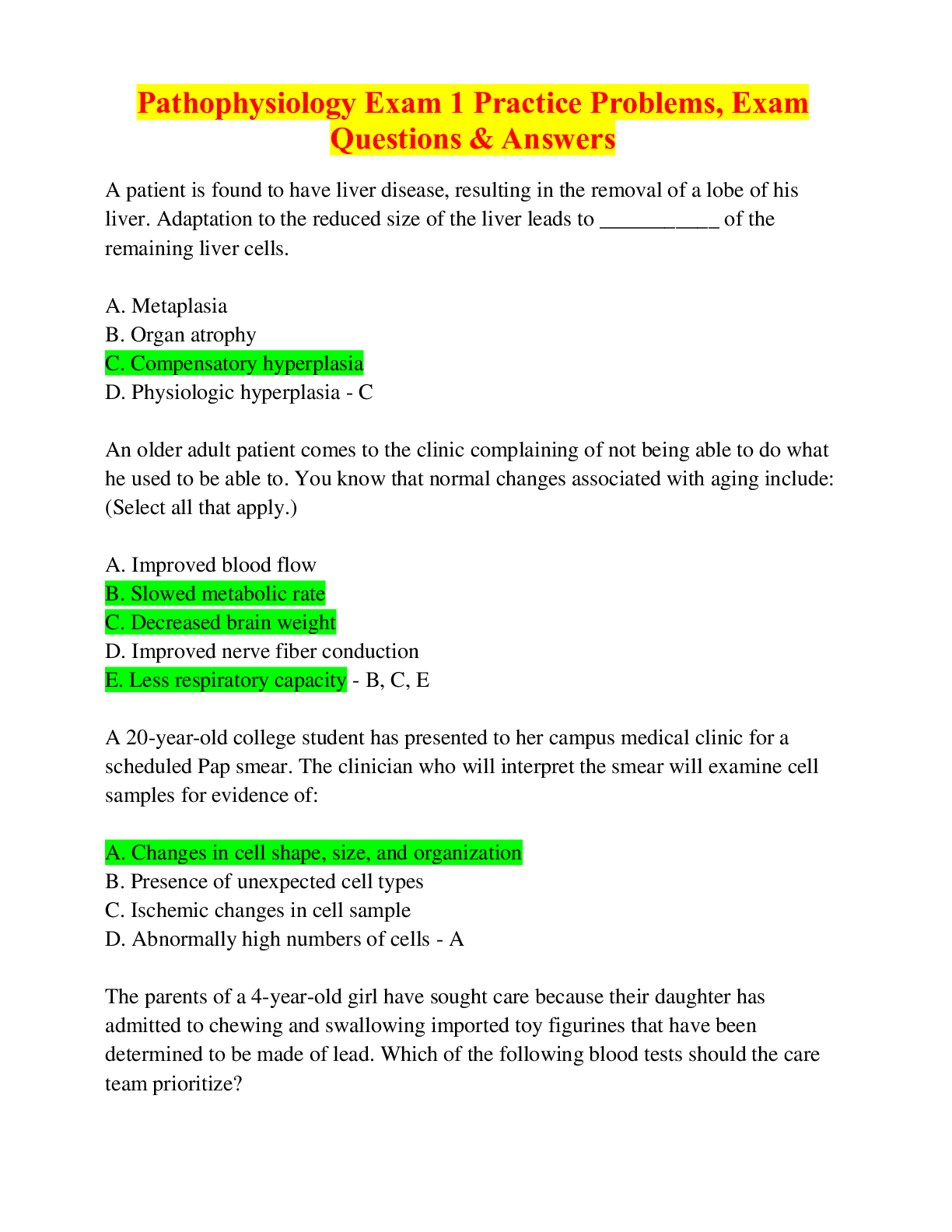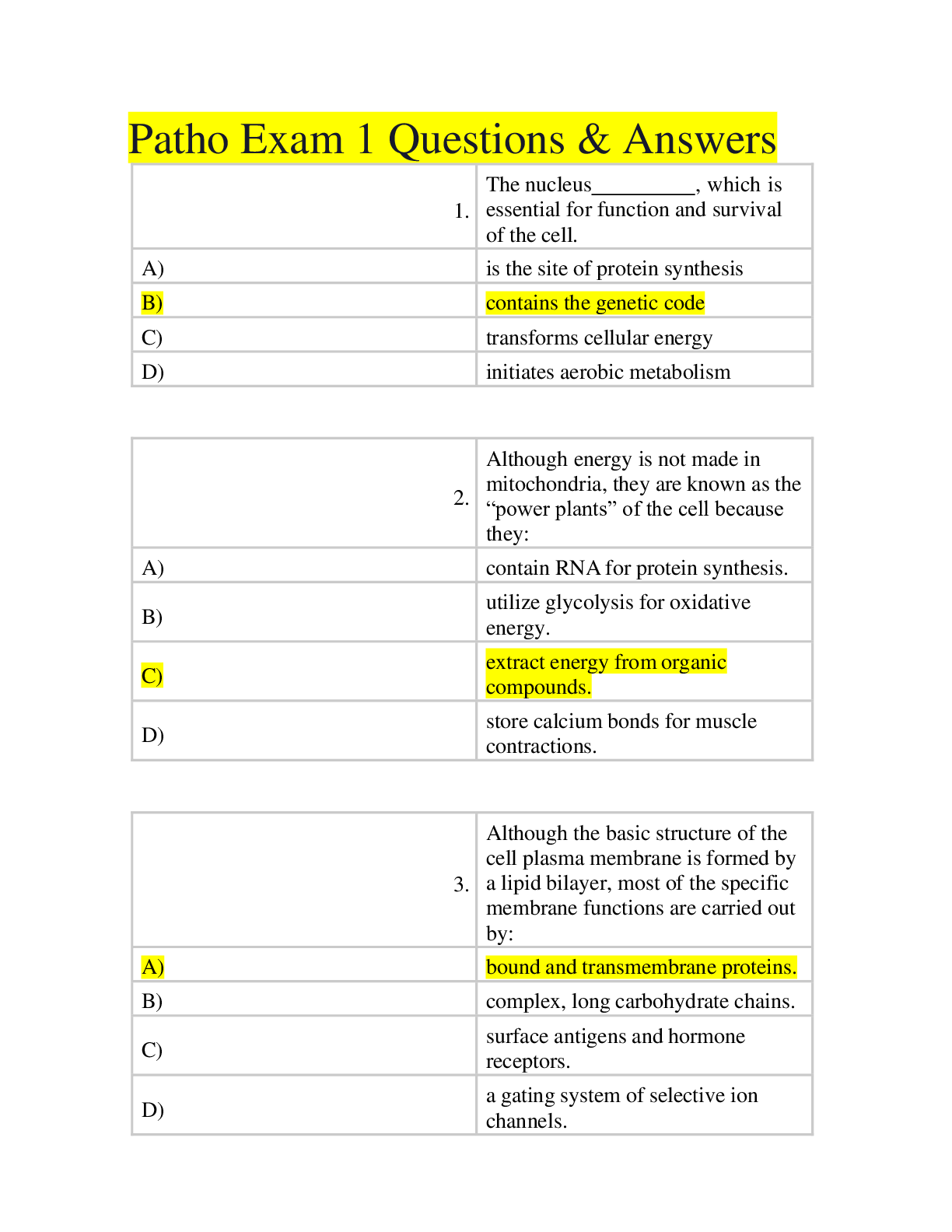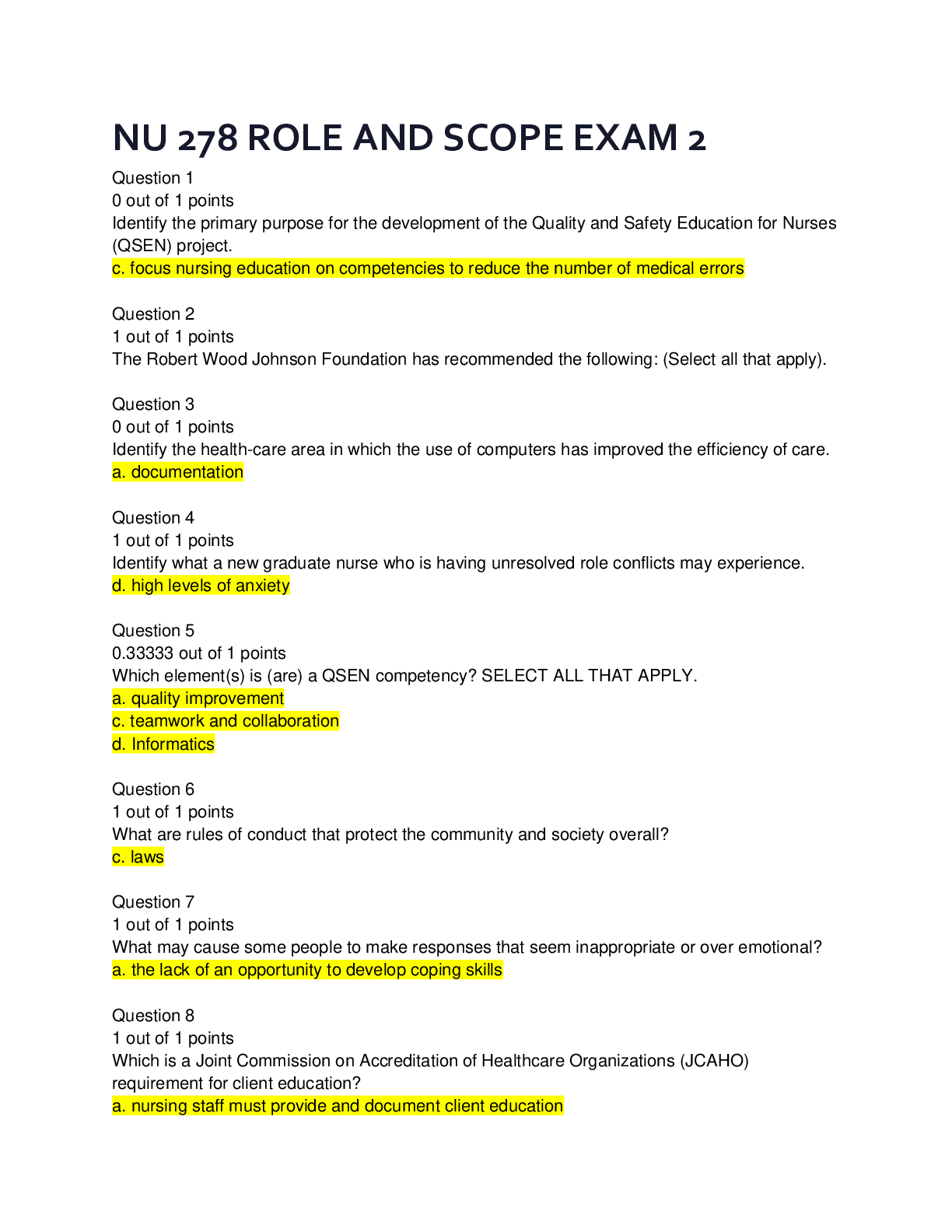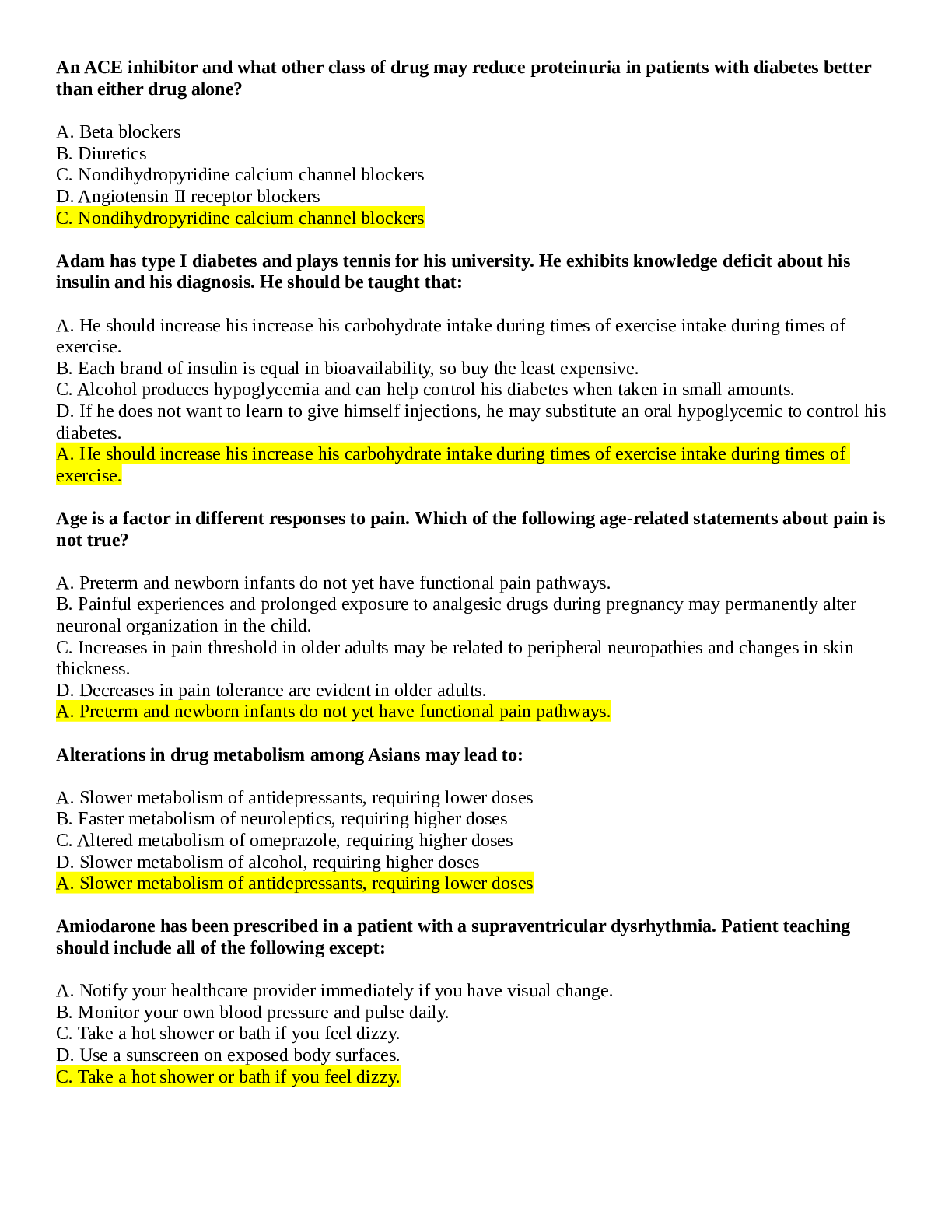*NURSING > EXAM > Child Health Nursing (NURS 4140) Exam 2 Questions & Answers (Explained With Rationales) (All)
Child Health Nursing (NURS 4140) Exam 2 Questions & Answers (Explained With Rationales)
Document Content and Description Below
Child Health Nursing (NURS 4140) Exam 2 Questions & Answers (Explained With Rationales)-A nurse is caring for a child who is near death. Which physical signs indicate the child is approaching death? (... Select all that apply.) a. Speech becomes rapid b. Difficulty swallowing c. Tactile sensation decreasing d. Body feels warm e. Change in respiratory pattern - The correct answers are: Tactile sensation decreasing, Change in respiratory pattern, and Difficulty swallowing. Physical signs of approaching death include tactile sensation beginning to decrease, a change in respiratory pattern, and difficulty swallowing. Even though there is a sensation of heat the body feels cool, not warm, and speech becomes slurred, not rapid. At which age do most children have an adult concept of death as being inevitable, universal, and irreversible? a. 12 to 13 years b. 6 to 7 years c. 9 to 11 years d. 4 to 5 years - The correct answer is: 9 to 11 years By age 9 to 11 years, children have an adult concept of death. They realize that it is inevitable, universal, and irreversible. The feeling of guilt that the child "caused" the disability or illness is especially critical in which child? a. Toddler b. Preschooler c. Adolescent d. School-age child - The correct answer is: Preschooler Preschoolers are most likely to be affected by feelings of guilt that they caused the illness or disability or are being punished for wrongdoings. Toddlers are focused on establishing their autonomy. The illness will foster dependence. The school-age child will have limited opportunities for achievement and may not be able to understand limitations. Adolescents face the task of incorporating their disabilities into their changing self-concept. The nurse is talking with the parents of a child who died 6 months ago. They sometimes still "hear" the child's voice and have trouble sleeping. How would the nurse interpret these feelings? a. These grief responses are more typical of the early stages of grief. b. This grieving is essential until the pain is gone and the child is gradually forgotten. c. These are normal grief responses. d. The pain of the loss is usually less by this time. - The correct answer is: These are normal grief responses. These are normal grief responses. The process of grief work is lengthy. The parents of a child born with disabilities ask the nurse for advice about discipline. Which information about discipline would the nurse's response include? a. It is not needed unless the child becomes problematic. b. It is essential for normal development. c. It is best achieved with punishment for misbehavior. d. It is too difficult to implement with a special-needs child. - The correct answer is: It is essential for normal development. Discipline is essential for the child. It provides boundaries on which to test out their behavior and teaches them socially acceptable behaviors. The nurse should teach the parents ways to manage the child's behavior before it becomes problematic. Punishment is not effective in managing behavior. When considering palliative care for a young child with a life-threatening illness, which is an important consideration? a. The family is included in the decision to shift the goals of treatment. b. The decision must be made by the health professionals involved in the child's care. c. The decision should not be communicated to the family because it will encourage a sense of hopelessness. d. The family needs to understand that palliative care takes place in the home. - The correct answer is: The family is included in the decision to shift the goals of treatment. When the child reaches the terminal stage, the nurse and physician should explore the family's wishes. The family should help decide what interventions will occur as they plan for their child's death. Which is a characteristic of chronic sorrow often experience by parents who have a chronically ill child? a. Periods of intensified sorrow when experiencing anger and guilt b. Lack of acceptance of the child's limitation c. Periods of intensified sorrow and loss that occur in waves over time d. Lack of available support to prevent sorrow - The correct answer is: Periods of intensified sorrow and loss that occur in waves over time. Chronic sorrow is manifested by feelings of sorrow and loss that recur in waves over time. The sorrow is in response to the recognition of the child's limitations. The family should be assessed in an ongoing manner to provide appropriate support as the needs of the family change. The sorrow is not preventable. The chronic sorrow occurs during the reintegration and acknowledgment stage. Which nursing intervention would the nurse include to help the siblings of a child with special needs cope? a. Encourage the parents not to expect siblings to help them care for the child with special needs b. Provide information to the siblings about the child's condition only as they request it c. Explain to the siblings that embarrassment is unhealthy d. Suggest to the parents ways of showing gratitude to the siblings who help care for the child with special needs - The correct answer is: Suggest to the parents ways of showing gratitude to the siblings who help care for the child with special needs The presence of a child with special needs in a family will change the family dynamic. Siblings may be asked to take on additional responsibilities to help the parents to care for the child. The parents should show gratitude, such as an increase in allowance, special privileges, and verbal praise. Embarrassment may be associated with having a sibling with a chronic illness or disability. Parents must be able to respond in an appropriate manner without punishing the sibling. The parents may need assistance with the care of the child. Most siblings are positive about the extra responsibilities. The siblings need to be informed about the child's condition before a nonfamily member does so. The parents do not want the siblings to fantasize about what is wrong with the child. A child with autism spectrum disorder (ASD) is admitted to the hospital with pneumonia. The nurse would plan which priority intervention when caring for the child? a. Place child in a room with a roommate of the same age. b. Maintain a structured routine and keep stimulation to a minimum. c. Maintain frequent touch and eye contact with the child. d. Take the child frequently to the playroom to play with other children. - The correct answer is: Maintain a structured routine and keep stimulation to a minimum. Providing a structured routine for the child to follow is a key in the management of ASD. Decreasing stimulation by using a private room, avoiding extraneous auditory and visual distractions, and encouraging the parents to bring in possessions the child is attached to may lessen the disruptiveness of hospitalization. Because physical contact often upsets these children, minimum holding and eye contact may be necessary to avoid behavioral outbursts. Children with ASD need to be introduced slowly to new situations, with visits with staff caregivers kept short whenever possible. The playroom would be too overwhelming with new people and situations and should not be a priority of care. [Show More]
Last updated: 5 months ago
Preview 1 out of 20 pages

Loading document previews ...
Buy this document to get the full access instantly
Instant Download Access after purchase
Buy NowInstant download
We Accept:

Reviews( 0 )
$13.50
Can't find what you want? Try our AI powered Search
Document information
Connected school, study & course
About the document
Uploaded On
Dec 30, 2024
Number of pages
20
Written in
Additional information
This document has been written for:
Uploaded
Dec 30, 2024
Downloads
0
Views
11
